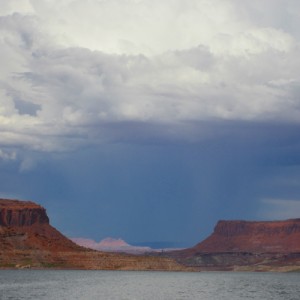What if bridges – your only connection with the outside world – washed away in a torrential rainstorm and the ensuing floodwaters? What if the Colorado River ran muddy as the Mississippi from the Glen Canyon Dam down to the Little Colorado River? How resilient could you be?
The river did just that this past week, as the sands picked up by Wahweap Creek sneaked through the penstocks of the dam, subversively clouding the water in Marble Canyon. (Being a little subversive myself, I imagined the dam gone altogether and the current slowed, seasonally wild and temperate, delivering nutrient-rich sediment through the canyon as it should, instead of that treasure being hoarded behind the concrete bunker of the dam.)
Mia, who lives in Estes Park, CO, had planned to come to Flagstaff for the bluegrass festival until the rains hit her town. Their camper was packed, and they were ready to leave, but all the bridges between them and the mainland washed out. Disappointed to miss the festival, they were lucky be safe and have enough food and supplies to withstand their seige.
I’m thinking a lot about resilience these days: how holding onto the truest thing you know, grasping it for all you’re worth, can save you from drowning. And how the flip side of that coin – letting go of everything you think you know – can also save you. Either way, you’ve lost something and gained something else.
As I prepare to leave for a couple of months, I find myself shaken to the core, as if a massive sinkhole was about to open beneath my feet. I crave that certain angle of light found only in Northern Arizona in the fall. I want to drive out to all the urgently beautiful places I know, to ground myself and drill these places into my heart.
My car was ready for the trip, but Saturday after a fairly major repair, it was making odd metallic noises, so I postponed my departure. My plan for a dreamy overland route – away from the interstate highways – evaporated, at least until I’m confident my car will make the journey without stranding me in some godforsaken backwater town. Still, driving across Utah and Nevada into Oregon feels like an adventurous thing to do: court a tiny bit of danger, and count on my own resilient spirit, test my tools and experience the generous wisdom of the universe.
I’ve been reading Michael Pollan’s latest book, Cooked. His description of the microcosm that is us has me intrigued; all the bacteria that live within the confines of our bodies add up to several pounds worth, apparently. One of the theories about why we carry these critters around is that they are more evolutionarily resilient than we are, quick to respond to new stimuli, new conditions. In a rapidly changing environment we can use all the help we can get, and so we’ve evolved to let “our” bugs do some of that work. We can hold onto our illusion of self-reliance, but we need others, human and subhuman.
 On a science trip uplake from Glen Canyon Dam this summer, I took lots of snapshots of beautiful rocks and sky and water. The clouds put on an especially good show, filtering the late summer light, bouncing it off the surface of the water, playing hide and seek with the moon and the stars. But what most impressed me most was the adaptive behavior of the water.
On a science trip uplake from Glen Canyon Dam this summer, I took lots of snapshots of beautiful rocks and sky and water. The clouds put on an especially good show, filtering the late summer light, bouncing it off the surface of the water, playing hide and seek with the moon and the stars. But what most impressed me most was the adaptive behavior of the water.
Sediment deposits at the Colorado River delta recently caused the river to change course from right to left: as the river slowed (from meeting the still water of the lake) it dropped sediment until it could no longer flow over the resulting sandbar, then diverted around it, over and over, until it ran along the opposite bank. We could see evidence of the river’s diversion in tracks on the sandbar, resilience made visible.
Anytime I go boating, I imagine walking along the river bottom and what its shape might be. Those contours remain a mystery, even when the water runs clear. But it’s like hiking through a streambed, not knowing what the next step will reveal under your feet. You can be ready for anything, as long as you step carefully, balance and keep a strong core.

